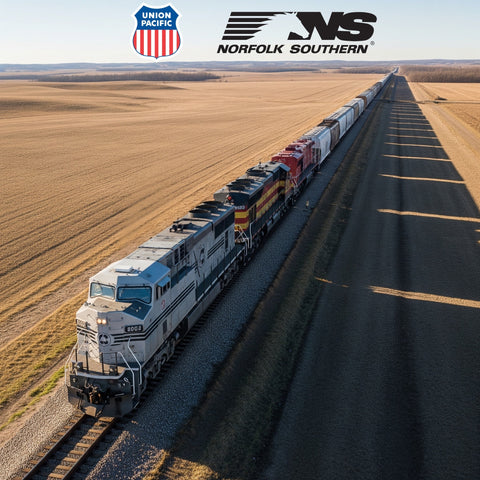$85 billion merger between Union Pacific and Norfolk Southern

July 29, 2025
The proposed $85 billion merger between Union Pacific and Norfolk Southern has sent ripples throughout the railroad sector and the broader logistics industry. Announced on July 29, 2025, this transformative deal is poised to create the first coast-to-coast freight rail operator in the United States, fundamentally altering the landscape of American transportation and supply chains. The transaction will see Union Pacific, the dominant railroad in the western United States, acquire Norfolk Southern, whose 19,500-mile network stretches across 22 eastern states. Together, the combined entity will control more than 50,000 route miles, linking over 100 ports and every major region from the Jersey Shore to the Pacific Coast.
Union Pacific’s CEO, Jim Vena, will lead the merged company, bringing decades of experience and a proven operational track record in the railroad sector. Mark George is the President and CEO of Norfolk Southern and has overseen its recent financial resurgence and operational improvements. Both leaders have publicly expressed optimism about the integration, with Vena emphasizing the long-term vision of a truly seamless, transcontinental freight rail service and George highlighting the strategic fit and opportunity for growth.

The merger agreement values Norfolk Southern at $320 per share, representing a roughly 25% premium over its 30-day trading average as of mid-July 2025. This cash-and-stock deal not only rewards Norfolk Southern’s shareholders but also positions the combined group with an estimated enterprise value above $250 billion. Financial projections anticipate about $2.75 billion in annual synergies, a pro-forma operating ratio of 62%, and annual revenues near $36 billion. Shareholders of Norfolk Southern will receive Union Pacific shares and $88.82 in cash for each Norfolk share, culminating in about 27% ownership of the unified company on a fully diluted basis. Importantly, the deal features a $2.5 billion reverse termination fee, underlining its seriousness.
Strategically, the merger brings the realization of a single operator capable of moving goods coast-to-coast under one network—an object that eluded the industry since the “golden spike” of 1869, when a single journey still required switching between separate railroads. For shippers, the promise is of accelerated delivery, reduced transfer bottlenecks, and more reliable cross-country supply chains. This transforms the U.S. import/export ecosystem by offering direct routes from ports in the east (such as Newark and Savannah) to those on the west (Los Angeles, Seattle), without the need for intermediary carriers.
Union Pacific expects the combination to boost efficiency for key cargo sectors, from agricultural products and energy to automotive and intermodal freight. Freight rail has been the backbone of U.S. industrial logistics, and this merger could further strengthen its competitive positioning against trucking and other forms of freight transport. Vena, the incoming CEO, has emphasized that railroads “have been an integral part of building America since the Industrial Revolution, and this transaction is the next step in advancing the industry”.
However, the deal is not without controversy and challenges. Labor unions—especially the largest, the Sheet Metal, Air, Rail and Transportation Workers-Transportation Division (SMART-TD)—are mounting opposition due to concerns over potential job losses and the companies’ labor practices. Past railroad consolidations, such as Union Pacific’s acquisition of Southern Pacific in 1996, resulted in massive logistical failures and congestion, fueling apprehensions that history could repeat itself. Regulatory scrutiny is certain to be intense, with the Surface Transportation Board and antitrust authorities closely examining the deal’s implications for competition, service, and labor.

Beyond the direct merger participants, the move applies competitive pressure on the remaining Class I railroads. BNSF and CSX will likely face considerable incentive to explore their own combination to maintain parity, raising the specter of a new wave of industry-wide consolidation. Canadian carriers, Canadian National (CN) and CPKC, operate extensive cross-border networks and may also seek strategic initiatives in response to preserve their own North American reach.
In sum, the proposed Union Pacific–Norfolk Southern merger represents the most ambitious integration in U.S. railroad history—one that, if approved, will reshape logistics, present huge operational opportunities, but also raise serious questions for regulators and labor. The final outcome remains subject to regulatory review, union negotiations, and market dynamics, but the business world is watching closely as a new era in American railroading may be on the horizon.


